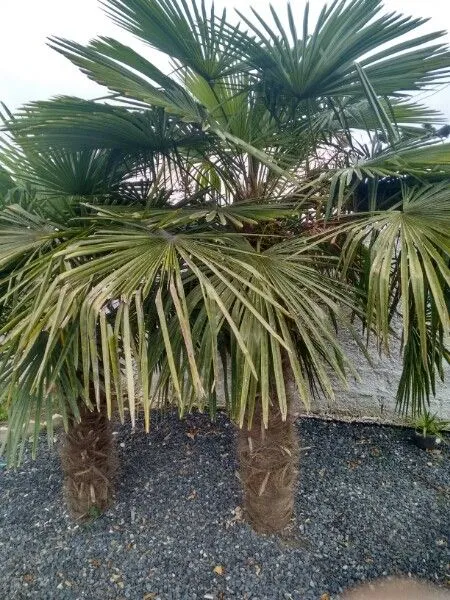
Author: (Hook.) H.Wendl.
Bibliography: Bull. Soc. Bot. France 8: 429 (1861)
Year: 1861
Status: accepted
Rank: species
Genus: Trachycarpus
Vegetable: False
Observations: SC. China to N. Myanmar
The Chinese windmill palm, scientifically known as Trachycarpus fortunei, is a distinguished species native to Southern China and Northern Myanmar. This evergreen palm is prized not only for its graceful appearance but also for its resilience in various climates, including relatively colder regions where many palms cannot thrive.
Characteristically, the Chinese windmill palm features a slender, fibrous trunk that is often enveloped with a durable husk of old leaf bases. The trunk can reach impressive heights, typically achieving anywhere between 10 to 20 meters in optimal growing conditions.
The striking fan-shaped leaves are among the most captivating features of Trachycarpus fortunei. These palmate leaves, radiating like the blades of a windmill, lend a distinctly tropical feel to gardens and landscape designs. The leaves are typically dark green, with their underside often showcasing a bluish-green tint. These large, lobed fronds measure around 90 centimeters in length and are supported by long petioles armed with fine teeth along the edges.
Flowering occurs in late spring to early summer, when the palm produces clusters of small, yellowish flowers that emerge from beneath the crown. These flowers are dioecious, meaning that individual plants are either male or female. If pollinated, the female flowers give way to bluish-black drupes that serve as the seeds of the Chinese windmill palm.
Beyond its ornamental appeal, the Chinese windmill palm is recognized for its adaptability and hardy nature. It can withstand temperatures as low as -15 degrees Celsius, making it one of the few palm species suitable for temperate climates. This hardiness, combined with its ability to grow in a variety of soil types—provided they are well-drained—makes it a versatile choice for landscapers and gardeners worldwide.
First formally described in 1861 in the Bulletin of the Botanical Society of France (Bull. Soc. Bot. France), the Chinese windmill palm was thoroughly classified by (Hook.) H.Wendl., and it belongs to the expansive family of Arecaceae.
Trachycarpus fortunei’s presence stretches beyond its native regions, enhancing both public and private gardens across continents. Its elegant silhouette, coupled with its tenacious adaptation to various environments, renders it a beloved and enduring choice for enhancing outdoor spaces.
Eng: chinese windmill palm, chusan fan palm, chusan palm, hemp palm, windmill palm
Fra: palmier de chine, palmier à chanvre
Deu: chinesische hanfpalme, hochstämmige hanfpalme
Spa: palma de jardín
Por: palmeira-moinho-de-vento
Swe: väderkvarnspalm
Nld: chinese waaierpalm
En: Chinese windmill palm, Chusan fan palm, Chusan palm, Hemp palm, Windmill palm
Ca: Palmera excelsa
Nl: Chinese waaierpalm, Chinese Windmolenpalm
Fr: Palmier de Chine, Palmier à chanvre, Palmier de Chusan, Palmier-chanvre
De: Chinesische Hanfpalme, Hochstämmige Hanfpalme, Fortunes Hanfpalme, Windmühlenpalme
It: Trachycarpus
Pt: Palmeira-moinho-de-vento
Es: Palma de jardín, Palmera de Fortune
Sv: Väderkvarnspalm
Taken Nov 2, 2016 by Giovanni Dahoué (cc-by-sa)
Taken Oct 19, 2022 by Marija Marincic (cc-by-sa)
Taken Jan 19, 2019 by Fejul Xeto (cc-by-sa)
Taken Jan 19, 2019 by Fejul Xeto (cc-by-sa)
Taken Jan 19, 2019 by Fejul Xeto (cc-by-sa)
Taken Nov 13, 2015 by Tela Botanica − julien grosse (cc-by-sa)
Taken Aug 28, 2019 by Quentin Quentin Ereac (cc-by-sa)
Taken Sep 21, 2022 by Fabrice Rubio (cc-by-sa)
Taken Nov 14, 2016 by Rodrigo Rodrigo (cc-by-sa)
Taken Jan 8, 2022 by Kai Best (cc-by-sa)
© copyright of the Board of Trustees of the Royal Botanic Gardens, Kew.
© copyright of the Board of Trustees of the Royal Botanic Gardens, Kew.
© copyright of the Board of Trustees of the Royal Botanic Gardens, Kew.
Taken Mar 17, 2015 by Hervé Goëau (cc-by-sa)
Taken Feb 28, 2022 by Loulou 2012 (cc-by-sa)
Taken Feb 28, 2022 by Loulou 2012 (cc-by-sa)
Taken Feb 16, 2022 by Marzanna Bug (cc-by-sa)
Taken Jan 8, 2022 by Kai Best (cc-by-sa)
Taken May 3, 2017 by Pierre Bonnet (cc-by-sa)
Taken Oct 29, 2022 by Leitão Elis (cc-by-sa)
Taken Oct 5, 2020 by vinay arora (cc-by-sa)
Taken Oct 12, 2019 by thehooklisbon (cc-by-sa)
Taken Feb 16, 2022 by Marzanna Bug (cc-by-sa)
Taken May 14, 2020 by juan llanos (cc-by-sa)
Taken May 14, 2020 by juan llanos (cc-by-sa)
Taken Apr 14, 2019 by sara dias (cc-by-sa)
Taken May 17, 2021 by Noza Yasu (cc-by-sa)
Taken Apr 17, 2018 by Zugna Fulvio (cc-by-sa)
Taken May 19, 2020 by Jette Zoéh Huntermann (cc-by-sa)
Taken Dec 8, 2002 by Alejandro Carrasco (cc-by-sa)
Taken May 4, 2022 by Stroncavanghe (cc-by-sa)
Taken May 30, 2021 by Jacques Maréchal (cc-by-sa)
Taken Oct 3, 2021 by Dieter Albrecht (cc-by-sa)
Family: Myrtaceae Author: (F.Muell.) K.D.Hill & L.A.S.Johnson Bibliography: Telopea 6: 402 (1995) Year: 1995 Status:…
Family: Rubiaceae Author: Pierre ex A.Froehner Bibliography: Notizbl. Bot. Gart. Berlin-Dahlem 1: 237 (1897) Year:…
Family: Sapindaceae Author: Koidz. Bibliography: J. Coll. Sci. Imp. Univ. Tokyo 32(1): 38 (1911) Year:…
Family: Asteraceae Author: A.Gray Bibliography: Pacif. Railr. Rep.: 107 (1857) Year: 1857 Status: accepted Rank:…
Family: Fabaceae Author: Medik. Bibliography: Vorles. Churpfälz. Phys.-Ökon. Ges. 2: 398 (1787) Year: 1787 Status:…
Family: Aspleniaceae Author: (Cav.) Alston Bibliography: Bull. Misc. Inform. Kew 1932: 309 (1932) Year: 1932…